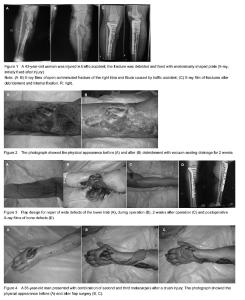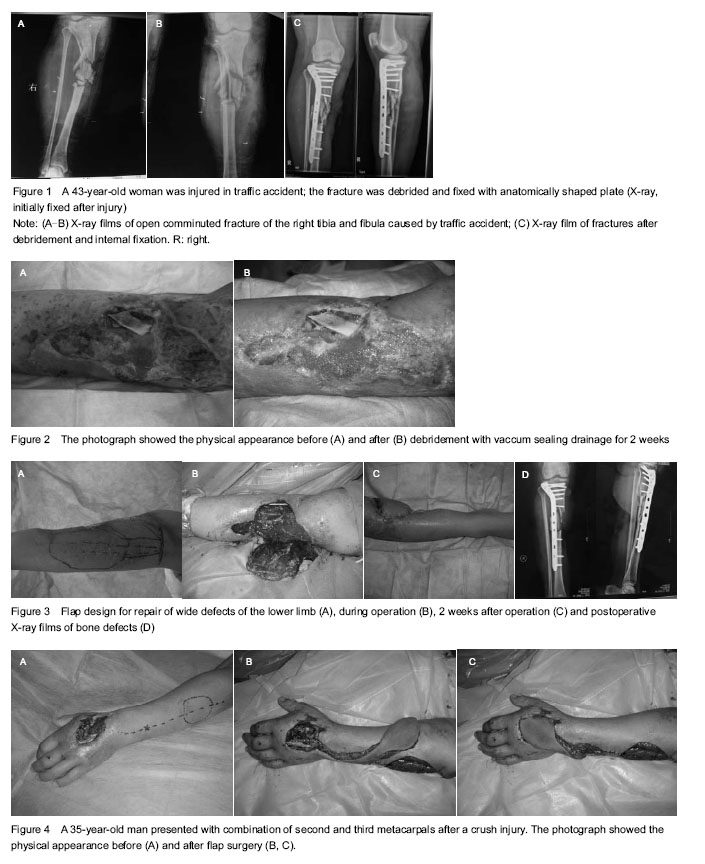Chinese Journal of Tissue Engineering Research ›› 2014, Vol. 18 ›› Issue (42): 6832-6837.doi: 10.3969/j.issn.2095-4344.2014.42.021
Previous Articles Next Articles
Perioperative management in traumatic soft tissue defects with revascularized flaps
Zhang Gui-chun, Cao Xue-cheng, Zheng Jin-long
- Department of Orthopaedic Trauma Surgery, Jinan Military General Hospital of Chinese PLA, Jinan 250031, Shandong Province, China
-
Revised:2014-09-09Online:2014-10-08Published:2014-10-08 -
Contact:Zhang Gui-chun, Department of Orthopaedic Trauma Surgery, Jinan Military General Hospital of Chinese PLA, Jinan 250031, Shandong Province, China -
About author:Zhang Gui-chun, Master, Associate chief physician, Department of Orthopaedic Trauma Surgery, Jinan Military General Hospital of Chinese PLA, Jinan 250031, Shandong Province, China
CLC Number:
Cite this article
Zhang Gui-chun, Cao Xue-cheng, Zheng Jin-long. Perioperative management in traumatic soft tissue defects with revascularized flaps[J]. Chinese Journal of Tissue Engineering Research, 2014, 18(42): 6832-6837.
share this article

Quantitative analysis of participants All flaps survived with no withdrawal. Effect of flap repair on traumatic soft tissue defects All flaps survived, there were no deep infections. Five flaps had minor tissue loss requiring subsequent small skin grafts, all of which healed. In these 94 cases, we had 5 cases of superficial necrosis of the flaps which healed with supportive therapy. There were no cases of complete necrosis. There were no donor site complications and no interference of muscle function at the donor sites. Of the operated cases, the results were excellent in almost all cases, but three cases required tenolysis which consisted of surgical release of tendon adhesions. For cases with joint capsule injuries, all Kirschner wires were removed after 6 weeks. Four cases of post-traumatic delayed and non-union (three of delayed union and one of non-union) were treated with musculo-periosteo-osteal decortication and autogenous cancellous bone grafts and finally healed. Typical cases Case 1: A 43-year-old woman was injured in traffic accident (open tibia fibula comminuted fracture, Gustilo III). The fracture was debrided and fixed with anatomically shaped plate, avascular necrosis developed, the vascular host bed and inserted plate were exposed during the debridement process. The patient was referred to our hospital 6 weeks later. The fracture was irrigated and debrided without anesthesia, closed suction drainage system was used to drain fluids, and the wound was covered with a surgical dressing for 2 weeks. Small fragments of loose bone were excised and discarded, and the musculocutaneous sural artery flap was used to cover the fracture. A small-diameter suction drain tube was inserted beneath the flap, and plates were maintained during healing (Figures 1-3). The bone defects were attempted to be reconstructed at second stage surgery. Case 2: A 35-year-old man presented with comminution of second and third metacarpals after a crush injury. The comminuted fracture was treated with open reduction and internal fixation in local hospital, and developed nonunion and avascular necrosis. The patient was referred to our hospital 2 weeks later. After the debridement of necrotic tissue in the sacral ulcer, the skin and soft tissue defects were reconstructed with a retrograde posterior interosseous artery flap. The flap was sutured, and the flap survived completely with extensor tendons and steels (Figure 4)."

| [1] Chan JK, Harry L, Williams G, et al. Soft-tissue reconstruction of open fractures of the lower limb: muscle versus fasciocutaneous flaps. Plast Reconstr Surg. 2012; 130(2):284e-295e. [2] Rubin JP, Marra KG. Soft tissue reconstruction. Methods Mol Biol. 2011;702:395-400. [3] Parrett BM, Matros E, Pribaz JJ, et al. Lower extremity trauma: trends in the management of soft-tissue reconstruction of open tibia-fibula fractures. Plast Reconstr Surg. 2006;117(4):1315-1322. [4] Tu YK, Yen CY, Ma CH, et al. Soft-tissue injury management and flap reconstruction for mangled lower extremities. Injury. 2008;39 Suppl 4:75-95. [5] Levin LS. Principles of definitive soft tissue coverage with flaps. J Orthop Trauma. 2008;22:S161-S166. [6] Nguyen TA. Soft tissue coverage at the resource-challenged facility. Clin Orthop Relat Res. 2008;466: 2451-2456. [7] Mateev MA, Ogawa R, Trunov L, et al. Shape-modified radial artery perforator flap method: analysis of 112 cases. Plast Reconstr Surg. 2009;123:1533-1543. [8] Akinbingol G, Borman H, Maral T, et al. Wound healing at adaptation zones of skin flaps harvested from acute burned skin. Burns. 2013;39(6):1206-1211. [9] Hallock GG, Morris SF. Skin grafts and local flaps. Plast Reconstr Surg. 2011;127:5e-22e. [10] Yang LC, Wang XC, Bentz ML, et al. Clinical application of the thoracodorsal artery perforator flaps. J Plast Reconstr Aesthet Surg. 2013;66:193-200. [11] Zhang AY, Meine JG. Flaps and grafts reconstruction. J Plast Reconstr Aesthet Surg. 2013;66(2):193-200. [12] Stein EM, Carrelli A, Young P, et al. Bariatric surgery results in cortical bone loss. J Clin Endocrinol Metab. 2013;98: 541-549. [13] Mader JT, Shirtliff M, Calhoun JH. Staging and staging application in osteomyelitis. Clin Infect Dis 1997;25: 1303-1309. [14] Braun M Jr, Cook J. The island pedicle flap. Dermatol Surg. 2005;31:995-1005. [15] Pignatti M, Ogawa R, Hallock GG, et al. The “Tokyo” consensus on propeller flaps. Plast Reconstr Surg. 2011; 127: 716-722. [16] Owens BD, Wenke JC. Early wound irrigation improves the ability to remove bacteria. J Bone Joint Surg Am. 2007;89: 1723-1726. [17] Moscati RM, Mayrose J, Reardon RF, et al. A multicenter comparison of tap water versus sterile saline for wound irrigation. Acad Emerg Med. 2007;14:404-409. [18] Draeger RW, Dahners LE. Traumatic wound debridement: a comparison of irrigation methods. J Orthop Trauma. 2006; 20:83-88. [19] Ousey K, McIntosh C. Understanding wound bed preparation and wound debridement. Br J Community Nurs. 2010;15(3):S22, S24, S26, passim. [20] Falanga V, Brem H, Ennis WJ, et al. Maintenance debridement in the treatment of difficult-to-heal chronic wounds. Recommendations of an expert panel. Ostomy Wound Manage. 2008;Suppl:2-13. [21] Alam N, McGrouther DA, Wong JK. The cellular biology of tendon grafting. J Hand Surg Eur Vol. 2013;39(1):79-92. [22] Duncan SF, Sperling JW, Steinmann SP. Infected distal biceps tendon repairs: three case reports. Clin Orthop Relat Res. 2007;461:14-16. [23] Cole BJ, Pascual-Garrido C, Grumet RC. Surgical management of articular cartilage defects in the knee. Instr Course Lect. 2010;59:181-204. [24] Vaid N, Vaid S, Manikoth M. Case report - biofilm infection of a cochlear implant. Cochlear Implants Int. 2013;14: 117-120. [25] Knott PD, Suh JD, Nabili V, et al. Evaluation of hardware-related complications in vascularized bone grafts with locking mandibular reconstruction plate fixation. Arch Otolaryngol Head Neck Surg. 2007;133:1302-1306. [26] Schepers T. To retain or remove the syndesmotic screw: a review of literature. Arch Orthop Trauma Surg. 2011;131: 879-883. [27] Schepers T, Van Lieshout EM, de Vries MR, et al. Complications of syndesmotic screw removal. Foot Ankle Int. 2011;32:1040-1044. [28] Covani U, Barone A, Cornelini R, et al. Clinical outcome of implants placed immediately after implant removal. J Periodontol. 2006;77:722-727. [29] Minkowitz RB, Bhadsavle S, Walsh M, et al. Removal of painful orthopaedic implants after fracture union. J Bone Joint Surg Am. 2007;89:1906-1912. [30] Bari S, Kulkarni U, Robinson G. Early implant removal: an ethical dilemma. J Fam Plann Reprod Health Care. 2013; 39(1):64. [31] Kim JI, Suh KT, Kim SJ, et al. Implant removal for the management of infection after instrumented spinal fusion. J Spinal Disord Tech. 2010;23:258-265. |
| [1] | Wang Canli1, 2, Jiao Zhili2, Sun Yong1, 2, Sun Song3 . Comparison of the effects of two kinds of platelet-rich fibrins on the proliferation activity of human gingival fibroblasts [J]. Chinese Journal of Tissue Engineering Research, 2019, 23(7): 1007-1012. |
| [2] | Cao Chang, Ren Xiaoyan, Meng Fanjun, Cheng Fengrui, Cen Ying. Research progress of ginsenosides Rb1 in flap ischemia/reperfusion injury [J]. Chinese Journal of Tissue Engineering Research, 2019, 23(7): 1129-1135. |
| [3] | Liu Dahai, Li Haibo, Gou Yongsheng, Li Liang. Effects of different body positions and traction weights on hip bursa pressure after femoral neck fracture [J]. Chinese Journal of Tissue Engineering Research, 2019, 23(36): 5846-5849. |
| [4] | Yan Guichun. Hyperbaric oxygen combined with edaravone for flap survival in rabbit models of ear tear injury [J]. Chinese Journal of Tissue Engineering Research, 2019, 23(15): 2380-2384. |
| [5] | Yan Wei, Luo Shihua, Jia Youji, Xi Xiaobing, Li Zhongwei. Process optimization of compound cotton rose hibiscus leaf ointment and its clinical efficacy and safety verification [J]. Chinese Journal of Tissue Engineering Research, 2019, 23(10): 1540-1545. |
| [6] | Li Xu-feng1, Liu Yuan-yuan2, Ren Shan-shan2, Wang Ai1, Lu Xiao-sheng2. Origin and trend of the upper eyelid artery in the eyelid region of a skull model after blood reperfusion: an anatomical observation [J]. Chinese Journal of Tissue Engineering Research, 2018, 22(8): 1241-1246. |
| [7] | Li Wen-bo, Zhang Chao, Shi Jie, Huang Qiang, Jia Ding-ding, Gao Qiu-ming. Choke vessel growth in perforator flaps and the conception of angiosome [J]. Chinese Journal of Tissue Engineering Research, 2018, 22(8): 1261-1266. |
| [8] | Huang Chang-jin, Song Wei-ming. Skin soft tissue expansion: history, development, technical revolution and application innovation [J]. Chinese Journal of Tissue Engineering Research, 2018, 22(8): 1267-1274. |
| [9] | Dou Zhe, Yang Yun, Huang Jian. Perioperative analgesia in total knee arthroplasty: measures and countermeasures [J]. Chinese Journal of Tissue Engineering Research, 2018, 22(23): 3716-3722. |
| [10] | Shi Si-feng, Lu Wen-hai, Zhou Bing, Chen Xiang-yang, Zhao Feng-chao, Guo Kai-jin . Protection of quadratus femoris and posterior soft tissue repair for the prevention of early dislocation in total hip arthroplasty through posterolateral approach [J]. Chinese Journal of Tissue Engineering Research, 2016, 20(48): 7163-7168. |
| [11] | Chen Yong, Fan Long-kun. MicroRNA-126 effects on free flap activity by regulating bone marrow mesenchymal stem cells [J]. Chinese Journal of Tissue Engineering Research, 2016, 20(36): 5332-5337. |
| [12] | Dong Hai-jiang, Wang Xi-mei, Wan Cheng, Li Xiang, Zhang Qiong-ge. Application of acellular dermal matrix and expanded flap in half auricular reconstruction with rib cartilage grafts [J]. Chinese Journal of Tissue Engineering Research, 2016, 20(24): 3541-3548. |
| [13] | Wang Zhong-chao, Fan Li-yuan, Cai Wei, Jiang Jun-qiang. Nano-cellulose protein versus acellular matrix in oral mucosa repair [J]. Chinese Journal of Tissue Engineering Research, 2016, 20(21): 3104-3109. |
| [14] | Liu Dong, Liang Yun-hai, Dong Ming, Jiang Yan-hui . Application of vacuum sealing drainage combined with skin flap transplantation in foot soft tissue repair [J]. Chinese Journal of Tissue Engineering Research, 2015, 19(7): 1133-1137. |
| [15] | Lao Shi-gao, Luo Ren, Meng Zhi-jian, Li Xu, Qiu Hong-sheng, Wei Zhen-fei. Relationship between artificial hip replacement dislocation and anterolateral approach in repairing hip joint capsule [J]. Chinese Journal of Tissue Engineering Research, 2015, 19(44): 7087-7091. |
| Viewed | ||||||
|
Full text |
|
|||||
|
Abstract |
|
|||||